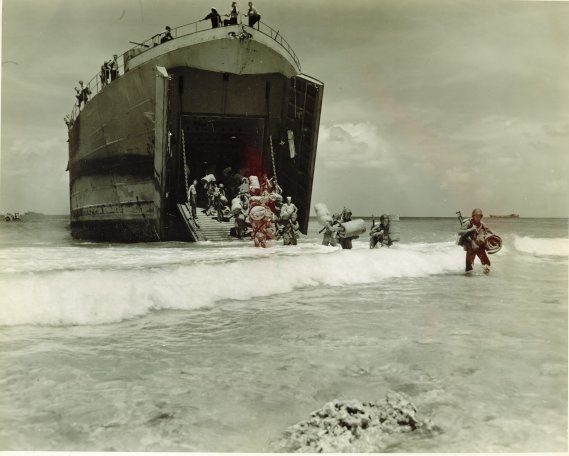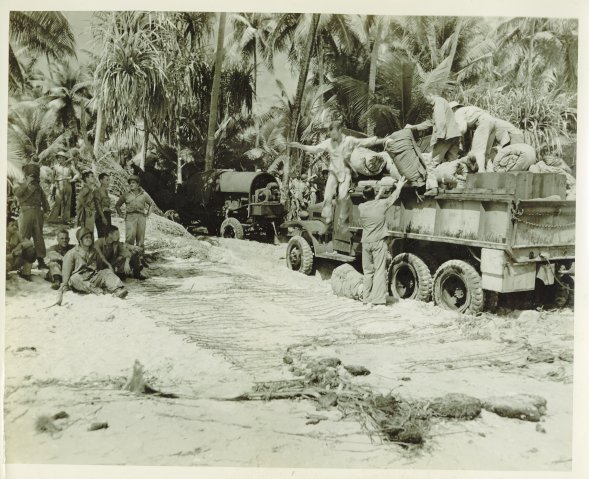Air Operations, Bismarcks
- In support of the amphibious assault on the Lae area, V Bomber Command B-25s attack the Cape Gloucester airfield on New Britain.
- 3rd Light Bomb Group A-20s and RAAF bombers attack the Gasmata airfield on New Britain.
- 11 RAAF Catalinas attack the Vunakanau and Lakunai airfields at Rabaul.
Air Operations, CBI
CHINA- 10 11th Medium Bomb Squadron B-25s, escorted by 11 23rd Fighter Group P-40s, attack the Tienho airfield at Canton during the early afternoon.
- 74th Fighter Squadron P-40s (including one Chinese Air Force pilot attached to the squadron) down 3 A6M Zeros over the Tienho airfield at Canton.
Air Operations, Europe
RAF BOMBER COMMANDEvening Ops:
- 8 Mosquitos are sent to Cologne and Duisburg and 25 Wellingtons and 13 Stirlings lay mines in the Frisians, in the Gironde River and off Lorient and St Nazaire.
- There are no losses.
BELGIUM:
33 387th Medium Bomb Group B-26s attack a marshalling yard at Courtrai at 1756 hours.
FRANCE:90 3rd Medium Bomb Wing B-26s attack marshalling yards at Hazebrouck, Lille, and St.-Pol-sur-Mer between 1756 and 1833 hours.
US 12th AIR FORCEITALY:
- XII Bomber Command B-17s dispatched to attack airdromes in southern Italy are forced to abort due to bad weather.
- 12th Air Force P-38s dispatched to attack the Grazzanise Airdrome are unable to find their target, but they attack targets of opportunity on the return flight.
- USAAF fighter-bombers and RAF light bombers attached to NATAF attack motor vehicles, roads, and rail junctions all across the toe of Italy, and gun emplacements around Reggio di Calabria.
- A 1st Fighter Group P-38 downs an Fi-156 observation plane near Cancello Arnone at 1800 hours.
Air Operations, New Guinea
- As Australian Army ground forces land at Hopoi, near Lae, 6 A6M Zeros followed by 3 G4M 'Betty' bombers attack troop-laden landing craft at 0705 hours. 1 Zero kills several Australian soldiers in one landing craft, and a 'Betty' sinks the craft with a direct hit and two very near misses.
- At 0800 hours, 9 V Bomber Command B-25s attack targets in the Hopoi area, and at about 0900 hours, 24 V Bomber Command B-24s attack gun emplacements and other targets at the Malahang airfield at Lae with 96 tons of bombs.
- At approximately 1400 hours, an estimated 100 Japanese bombers and fighters are intercepted over the departing Lae invasion flotilla by approximately 40 V Fighter Command P-38s and 20 348th Fighter Group P-47s. D3A 'Val' dive bombers score hits on an LST and near misses on 2 US destroyers, and 1 of 12 G4M 'Betty' bombers armed with torpedoes scores a hit on a troop-laden LST that kills 51 and wounds 30. Otherwise, little damage results, especially to vulnerable supplies stacked in the beachhead area.
- A 475th Fighter Group P-38 downs an A6M Zero over Hopoi at 0830 hours. P-38s of the 8th, 35th, and 475th Fighter groups down 11 A6M Zeros, 1 D3A 'Val' dive bomer, 3 Ki-43 'Oscar' fighters, and 2 G4M 'Betty' bombers over Huon Gulf, Lae, and Salamaua between 1345 and 1420 hours. Aa 348th Fighter Group P-47 downs an 'Oscar' and a 'Betty' near Hopoi at 1430 hours. 2 more 'Bettys' are downed by fire from the ships and landing craft.
Air Operations, Solomons
- 23 42nd Medium Bomb Group B-25s attack Dulo Cove.
- 9 AirSols B-24s and more than 35 fighters attack the airfield at Ballale.
Eastern Front
With no halt in their relentless advance the troops of Konev and Malinovsky take Merefa, a railway junction south of Kharkov. The last escape route left to the Germans in this sector is thus closed.
Hitler, yielding to the evidence for once, authorizes the evacuation of the remaining German forces holding the bridgehead in the Kuban, the powerfully fortified and mined 'blue line'.
The Germans execute a fighting withdrawal from the vital mining region in the Don basin.
SOUTHERN SECTORHitler gives the 17th Army permission to pull out of the Kuban and redeploy to the Crimea.
[New Guinea
The diversionary action against Salamaua carried out by the Australian 5th Div and the American 162nd Inf Regt comes to an end and the big offensive against Lae, the biggest Japanese base in New Guinea, opens.
After a short naval bombardment the Allies land on Huon Gulf, 14 and 18 miles east of Lae. The troops are 20th and 26th Bdes from 9th Australian Div. There is little Japanese resistance with the only real opposition coming from their air force, which damages several landing craft, but is then driven off by Allied aircraft, which enjoy great numerical superiority. While one Australian brigade moves off westward toward Lae, other units thrust to the east toward Hopoi, the capture of which will protect the eastern flank of the beachhead. The naval forces include 10 US destroyers, led by Adm Daniel E. Barbey.
[Pacific
- The US submarine Albacore (SS-218) sinks the Japanese gunboat Hiejo Maru (2627t) southwest of Ponape, Carolines.
- The US submarine Sunfish (SS-281) sinks the Japanese army cargo ship Kozan Maru (4180t).
- The US submarine Tarpon (SS-175) sinks the Japanese guardboat Yulin Maru in the northern Pacific.
Solomons
On Arundel, the 2nd Battalion of the 172nd Infantry, 43rd Division, moves by sea to the Stima Peninsula. After an amphibious move from Nauro to Bustling Point, the 1st Battalion begins an advance to control of the entrance to Wana Wana Lagoon.
[
|
|

